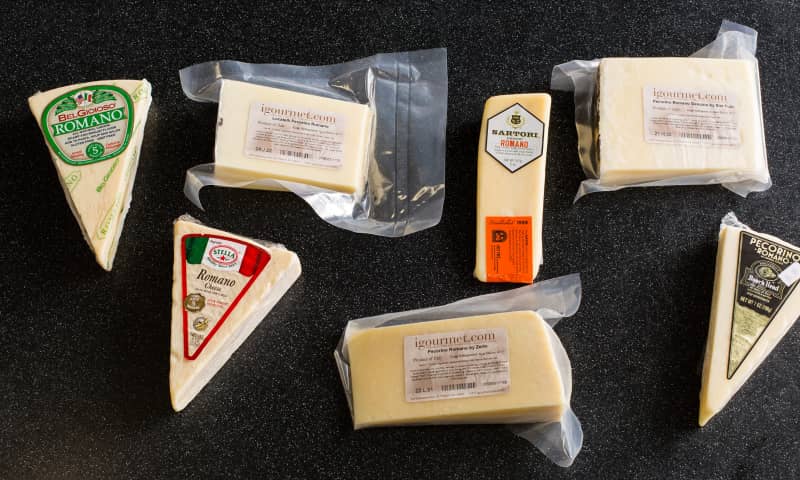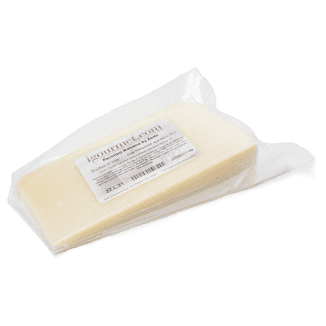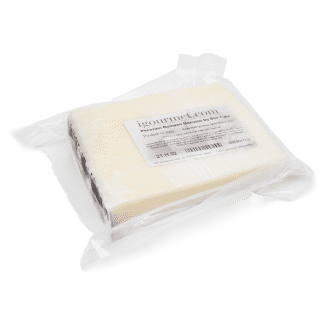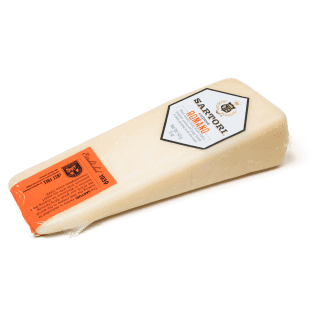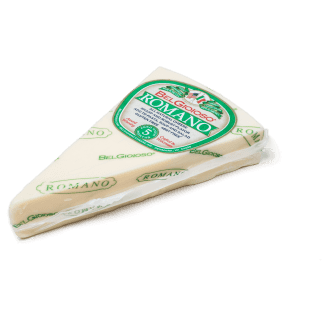Pecorino Romano is like the seasoned character actor who improves dozens of movies but never quite gets recognition. It’s one of the oldest cheeses in the world, named for its origins in ancient Rome, and its firm, slightly oily, crystalline texture and salty, funky flavor deserve fresh consideration out of the shadow of its more famous cousin, Parmigiano‑Reggiano. In the test kitchen, we use it in a number of salads, vegetable dishes, soups, and frittatas, not to mention classic Italian pasta dishes such as cacio e pepe, pasta all'amatriciana, and lasagna, where its rich, complex flavor is a quiet powerhouse.
But does it matter which cheese you bring home? We chose seven nationally available versions. In supermarkets, you’ll find cheese labeled Pecorino Romano and Romano sold side by side, so we included both. In blind tastings, we asked panels to evaluate the cheeses both plain and cooked in our recipe for Spaghetti with Pecorino and Black Pepper (Cacio e Pepe). To help us understand our preferences, we sent samples to an independent laboratory to measure their pH and compared the nutrition content provided on product labels.

Pecorino Romano versus Romano: What’s the Difference?
With Denominazione di Origine Protetta (DOP) status in the European Union, the cheese called Pecorino Romano can be made only in Lazio (the province that includes Rome), in Grosseto in Tuscany, and on the island of Sardinia, where most of it is produced today. It’s made with sheep’s milk (pecora means “sheep” in Italian) from local flocks that is heated and curdled with rennet from local lambs. Then the cheese is pressed, rubbed repeatedly with salt, stamped with identifying marks, and aged, all according to the standards of a consortium that oversees its production. This results in a unique cheese that is important in central and southern Italian and Italian American cooking. As early as 1911, Italian immigrants were ordering it shipped to America. Today, Italy produces 25,000 tons of the cheese per year; 60 percent of that is exported, and the top buyer is the United States. Perhaps surprisingly, Pecorino Romano accounts for a third of all Italian cheese exported to America. American cheesemakers, however, lacking access to sheep’s milk on an industrial scale, make Romano cheese with cow’s milk.

In both blind tastings, plain and in pasta, our tasters preferred imported Pecorino Romanos over domestic Romanos. While we didn’t dislike the domestic cheeses, our consensus was that they were simply not the same: milder, softer, less aromatic, and more like Swiss cheese than sharper, funkier, more crumbly, crystalline Pecorino Romano. Soft texture and mild flavor were understandable, since cheese becomes firmer and its flavor more complex the longer it is aged; our domestic Romanos were aged for as little as five months, compared with more than eight months for the imports. And the two lowest-ranked domestic cheeses had the lowest pH in the lineup, which indicates younger cheese; this higher acidity can lead to a slightly sour flavor and a pebbly texture that our tasters noticed when we sampled the cheeses plain. The imports contained more sodium, providing a deeply savory taste—and our winner had the most sodium of all. (It’s meant to be salty: Italian cooks often reduce salt in dishes where Pecorino Romano is prominent.) Finally, the basic flavor profiles of the domestic and imported cheeses didn’t match up.
Cow’s-Milk versus Sheep’s-Milk Cheese
Simply put, cow’s milk and sheep’s milk make different cheeses. Sheep’s milk has many short-chain and medium-chain fatty acids, while cow’s milk contains long-chain fatty acids, so they break down into different aroma compounds, explained Sarah Hoffmann, founder of Green Dirt Farm in Weston, Missouri, which produces small-batch sheep’s-milk cheeses. Certain fatty acids that create the gamy, funky taste of goat cheese appear in very small concentrations in sheep’s milk, too, but they’re absent from cow’s milk, she said.

Domestic Romano cheesemakers try to re-create some of the pungency of Pecorino Romano by adding lipase to the cow’s milk, explained Dean Sommer, senior food technologist for the Center for Dairy Research at the University of Wisconsin–Madison. This enzyme digests and breaks down dairy fat into fatty acids and glycerol, and in the process, it lends flavor and aroma to the cheese. In Sommer’s opinion, while this does create “strong” flavors, it doesn’t quite succeed in making cow’s-milk Romano taste like Pecorino Romano. Instead, he said, the result is “very similar to aged provolone cheese.” Anna Thomas Bates, co-owner of sheep’s-milk cheese producer Landmark Creamery in Albany, Wisconsin, agreed: “You just can’t duplicate the chemical makeup of sheep’s milk.”
Why Sheep?
Much of the rocky, arid terrain around the Mediterranean is not ideal for cattle. Smaller herd animals such as sheep and goats are better adapted for navigating and foraging for the sparse vegetation, so sheep’s- and goat’s-milk cheeses are the natural product in these regions. Some of the more famous sheep’s-milk cheeses include feta and halloumi from Greece, Manchego and Idiazabal from Spain, and Roquefort from France. In Italy, every sheep’s-milk cheese is called “Pecorino,” since the word pecora simply means “sheep.” Its second name—such as Romano or Toscano—designates its particular origin and/or style.
In the United States, we lack this tradition of sheep’s-milk cheese, said Hoffman. “From the 1600s in America, cheese was a commodity, made to be shipped to the Caribbean in trade for rum,” she said. “If you’re coming at it from the standpoint of trying to make money, you’re going to go for the animal that will produce the most milk, and that’s the cow. Sheep are very low-volume milk producers relative to other animals. You get one-quarter of what a goat produces and one-tenth of what a cow produces.

Sheep’s milk is renowned for its excellent composition for cheese making, with nearly twice the protein, fat, calcium, and solids of cow’s milk and an ability to develop complex, rich, fruity, toasted-nut, caramel, toffee, and even browned butter–like flavors as the cheese ages. So why don’t domestic cheese manufacturers make an effort to produce more sheep’s milk and age it more to make firmer, more flavorful Romano?
There are a few reasons. First, a sheep produces about one-tenth the volume of milk that a cow does, Hoffmann explained, so it’s much more expensive. Basic “commodity” cow’s milk costs about $0.15 per pound in the United States, while organic, grass-fed versions sell for $0.35 per pound, said Bates. Compare that with sheep’s milk, at $0.80 to $1.20 per pound, respectively. Second, American sheep breeds produce even less milk than those in Europe. (Federal bans on importing higher-yield breeds were lifted in 2017, so this is beginning to change.) Third, “aging is an expensive undertaking for producers, as it ties up inventory for long stretches of time—often months or years,” said Nora Weiser, executive director of the American Cheese Society (ACS). “So while I feel we’ll see more sheep’s-milk cheeses from smaller and specialty producers, it may not be something that big U.S. companies gravitate toward.” Still, sheep’s-milk cheeses are trending: More American consumers are seeking them out, and more domestic artisan cheesemakers are making them, Weiser said, noting that an ACS study showed a 40-percent increase in domestic sheep’s-milk cheese production between 2010 and 2016. ACS added a sheep’s-milk cheese category to its competition in 2017 for the first time, reflecting the growing number of entrants.
What's That Black Stuff on the Rind?
The black substance on the rinds of some Pecorino Romano cheeses is a food-safe paint that is sprayed on. You should scrape it off before grating or using the rind as flavoring, to avoid getting the black color in your dishes. If you do eat some, it won’t hurt you, and it’s flavorless, said Michele Buster, vice president and founder of New York–based Forever Cheese, importer of black-rinded Fulvi Pecorino Romano. While we’re all for tradition, we’re grateful that some things have changed with the times: Buster said the color is a modern take on the ancient practice of protectively coating the rind with mud.
As for our lineup, we recommend all of the imported Italian Pecorino Romano cheeses, but our top choice was the “pungent, salty, and sharp” Boar’s Head Pecorino Romano, which is widely available and moderately priced. (Note: This cheese is made in Italy following DOP guidelines, but because the wheels are cut and repackaged in the United States, the wedges are considered non-DOP, a Boar’s Head spokesperson confirmed.) In a pinch, a domestic Romano will do, but if you are like our tasters, you may regret not having the extra richness and complexity that Pecorino Romano brings to the table.

- Taste plain (at room temperature)
- Taste in our Spaghetti with Pecorino and Black Pepper (Cacio e Pepe)
- Made of sheep’s milk
- Aged longer than 8 months
- Firm, crumbly, crystalline texture
- Higher sodium level
- Higher pH (5.3 to 5.6)
